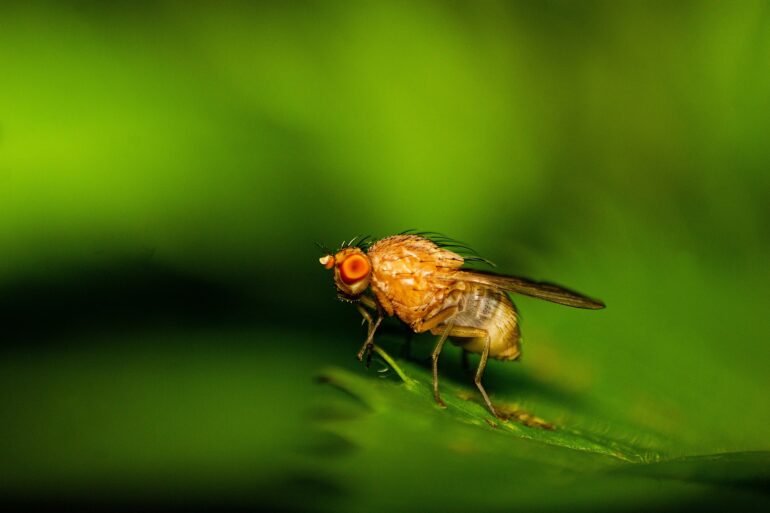TL;DR:
- Tulane University introduces MAFDA, a groundbreaking AI tool for tracking and analyzing complex fruit fly behaviors.
- MAFDA uses cameras and advanced software to monitor individual flies within a group, facilitating comparisons of behaviors across different genetic backgrounds.
- Fruit flies have been instrumental in deciphering mysteries of inheritance and immunity, with 60% of their DNA shared with humans.
- Previous algorithms were less accurate, but MAFDA simplifies the study of these insects.
- The platform speeds up research, reduces errors, and provides intricate insights into behavior genetics.
- MAFDA’s recent study challenges the notion that separate genes control pheromone production and perception.
- The tool holds the potential for studying other insects, mice, fish, and drug effects.
Main AI News:
In a remarkable breakthrough, Tulane University researchers have unveiled a cutting-edge AI tool that has the ability to monitor and decipher intricate behaviors of fruit flies. While this may sound like the setup to a lighthearted joke, the truth is that the researchers at Tulane have developed a groundbreaking system known as MAFDA (Novel Machine-learning-based Automatic Fly-behavioral Detection and Annotation), which employs advanced cameras and software to track and identify individual fruit flies within a larger group. This innovative technology enables scientists to compare and contrast the behaviors of fruit flies with varying genetic backgrounds, opening up new avenues of research in the field.
The scientific community has long recognized the extraordinary value of fruit flies as a model organism. Their simple genome and short lifespan have facilitated numerous breakthroughs in understanding the mysteries of inheritance and immunity in humans, earning six Nobel Prizes for studies on Drosophila melanogaster. Astonishingly, fruit flies and humans share an astonishing 60 percent of the same DNA, highlighting the significance of studying these remarkable creatures.
Previous attempts to track individual flies within a group using conventional algorithms were fraught with accuracy issues. However, the MAFDA system represents a monumental leap forward, simplifying the study of these minuscule, winged insects. “Fruit flies are like pioneers in the discovery of new things, from the chromosome theory of inheritance to innate immunity. To be able to quantify the flies’ behavior is really a step forward in behavior studies,” emphasized Wu-Min Deng, PhD., corresponding author, professor of biochemistry and molecular biology, and the Gerald & Flora Jo Mansfield Piltz Endowed Professor in Cancer Research at Tulane School of Medicine.
The brainchild of Wenkan Liu, a graduate student at the School of Medicine, the MAFDA platform holds immense promise. Liu highlights the undeniable significance of this tool, stating that it expedites research, minimizes human error, and provides intricate insights into behavior genetics. With the potential to revolutionize large-scale behavioral analysis, MAFDA is poised to enhance reproducibility and pave the way for new frontiers in research.
MAFDA was developed as part of a recent study that made a groundbreaking discovery linking the gene responsible for fruit flies’ perception of pheromones with the gene controlling pheromone production itself. This breakthrough finding, published in Science Advances, challenges the prevailing belief that separate genes regulate pheromone production and perception. Moreover, it has broad implications in the fields of human behavioral evolution, metabolism, and sex dimorphism.
Looking ahead, the researchers envision vast applications for MAFDA. Jie Sun, lead author and postdoctoral fellow at Tulane School of Medicine, emphasizes that MAFDA could eventually be employed to study other insects, as well as mice and fish. Furthermore, the system holds potential for investigating the effects of various drugs. “The more information we give the machine, the better it gets at correctly identifying different behaviors, from courtship to feeding and beyond,” explains Sun. “This is an extraordinarily important and meaningful tool.“
Already in use for ongoing research projects at Tulane, MAFDA is undergoing refinement to ensure its accessibility to a broader scientific community both locally and globally. “That’s the goal,” states Deng. “While initially aimed at identifying the health status of flies, we hope that this technology will be embraced by the wider scientific community, potentially leading us in that direction in the future.” With its ability to revolutionize behavioral analysis and transform our understanding of fruit flies, MAFDA holds immense promise as a groundbreaking tool in the world of scientific research.
Conclusion:
The introduction of MAFDA represents a significant advancement in fruit fly behavior analysis. This groundbreaking AI tool from Tulane University revolutionizes the tracking and identification of complex behaviors in these insects. Its potential impact extends beyond fruit flies, as it could pave the way for studying other organisms and analyzing the effects of drugs. The enhanced accuracy, efficiency, and reproducibility offered by MAFDA have the potential to transform large-scale behavioral analysis and open up new possibilities for scientific exploration in various fields.

